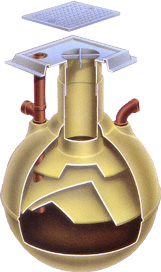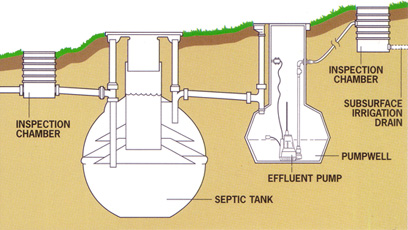Septic tank

Over the years Septic Tanks have come in a number of forms - from brick built or concrete holding
tanks, to converted wells. In the past water usage levels were much lower than today, and few
detergents were in common use - traditional rural methods of discharge such as ‘bucket and
chuck-it’ or open sewers located in the bog in the bottom field were adequate.

Modern living has led to far higher levels of water usage, and combined with the now high levels
of cleaning materials used by modern household equipment, the old methods of disposal have become
overwhelmed and old systems are failing. Even where old systems are still operating
satisfactorily and without problems to the environment, the Environment Agency and Building
Control consider the three stage settlement tank principle to be best practice for all new
installations, and consider that some old systems should be upgraded. The most common style of
Septic Tank is the familiar ‘onion’ shape which is available from most builders’ merchants.
Existing brick/concrete installations may only need additional settlement tanks to ensure the
solids are retained prior to discharge to the sub-soil. Septic tanks hardly treat effluent, but
merely facilitate the settlement of solids, before allowing the liquor to overflow and be
dispersed within the sub-soil, by means of soakaway. (See Soakaway) The resulting discharge
is highly pollutant and must not be allowed to appear on the surface nor enter a watercourse.
Should it do so, it will smell, cause an environmental hygiene problem and, if fed into a stream
will cause the death of fish and plant life, rendering the ‘creator of the waste’ liable to
prosecution and fines.

In cases of unequal levels, or where the situation does not allow for gravity feeding, a pump-set
can be installed after the septic tank to lift the discharge from the septic tank to a soakaway
located on higher ground. It is not recommended to pump to a septic tank as the maceration causes
turbulence and affects the settlement of the waste, which can allow carry-over of suspended
solids to the soakaway.
There a number of conversion kits available on the market to change some septic tanks to a
treatment plant.
A septic tank pump-set can be used to disperse settled effluent when a site has a high water
table or adverse invert levels. Details are available from S&B Services.